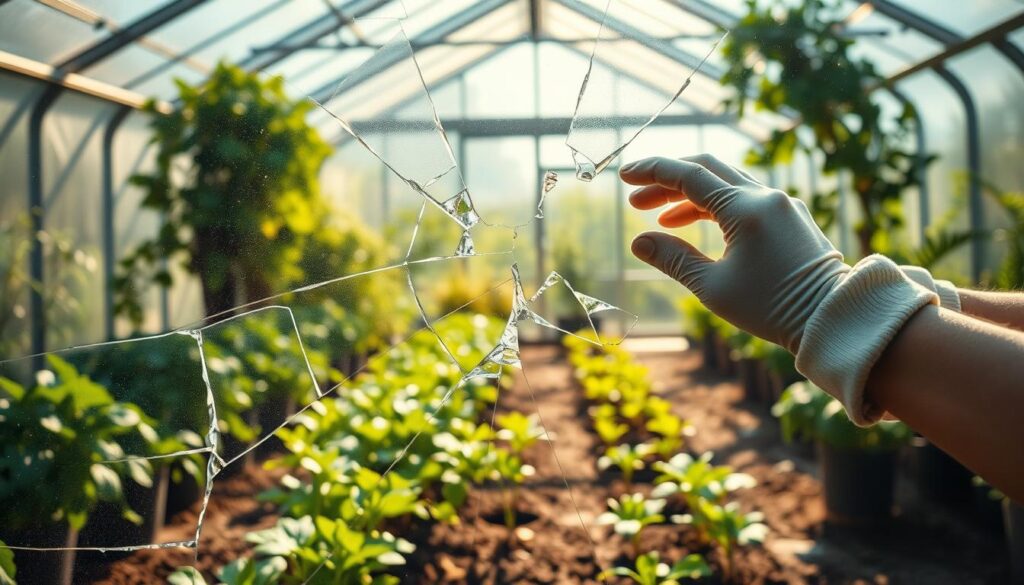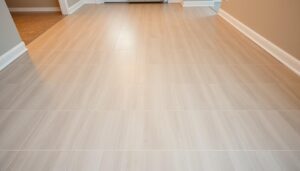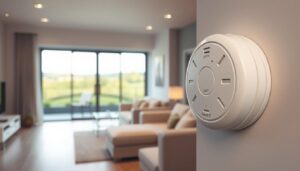Are you struggling to maintain optimal growing conditions for your plants due to a damaged greenhouse pane?
Replacing a broken pane is crucial to prevent further damage to your structure and ensure your plants receive the necessary light and warmth.
You have various material options for greenhouse glazing replacement, including traditional glass, acrylic, and polycarbonate panels. Modern alternatives like acrylic and polycarbonate are becoming increasingly popular among UK greenhouse owners due to their improved light transmission and enhanced durability.
Key Takeaways
- Understand the importance of promptly replacing damaged greenhouse panes.
- Learn about various material options for greenhouse glazing replacement.
- Discover the benefits of using modern alternatives like acrylic and polycarbonate.
- Get an overview of the replacement process and factors to consider when selecting new materials.
- Understand the cost implications and long-term benefits of different greenhouse glazing materials.
Understanding Your Greenhouse Glazing Options
Greenhouse glazing is a critical component, and choosing the right material is essential for durability and plant health. The glazing material you select can significantly affect the overall performance of your greenhouse, influencing factors such as light transmission, insulation, and resistance to weather conditions.
Traditional Glass Panes: Pros and Cons
Traditional glass panes have been used for greenhouses for centuries, offering excellent light transmission and aesthetic appeal. However, they can be heavy, prone to breakage, and may not provide the best insulation. Despite these drawbacks, glass remains a popular choice due to its clarity and durability.
Acrylic Greenhouse Glazing
Acrylic glazing is another popular option, known for its impact resistance and lighter weight compared to glass. It allows for good light transmission and can be more cost-effective than glass. However, it may become discoloured over time and can be prone to scratches.
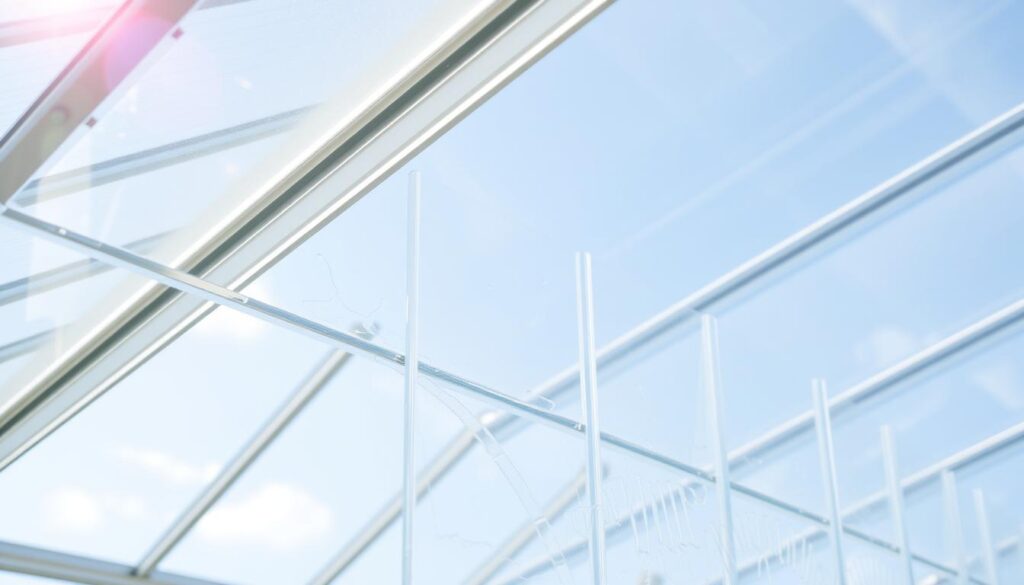
Polycarbonate Panels for Greenhouses
Polycarbonate panels are highly regarded for their exceptional impact resistance, being approximately 250 times stronger than standard glass. They offer excellent light transmission, are lighter, and easier to install than glass. While they can be more susceptible to scratches, their durability and weather resistance make them an excellent choice for greenhouse glazing.
- Impact Resistance: Polycarbonate greenhouse panels are extremely durable against hail and other impacts.
- Light Transmission: Clear polycarbonate provides excellent light transmission, supporting healthy plant growth.
- Durability: The material is designed to withstand extreme weather conditions, including strong winds and snow loads.
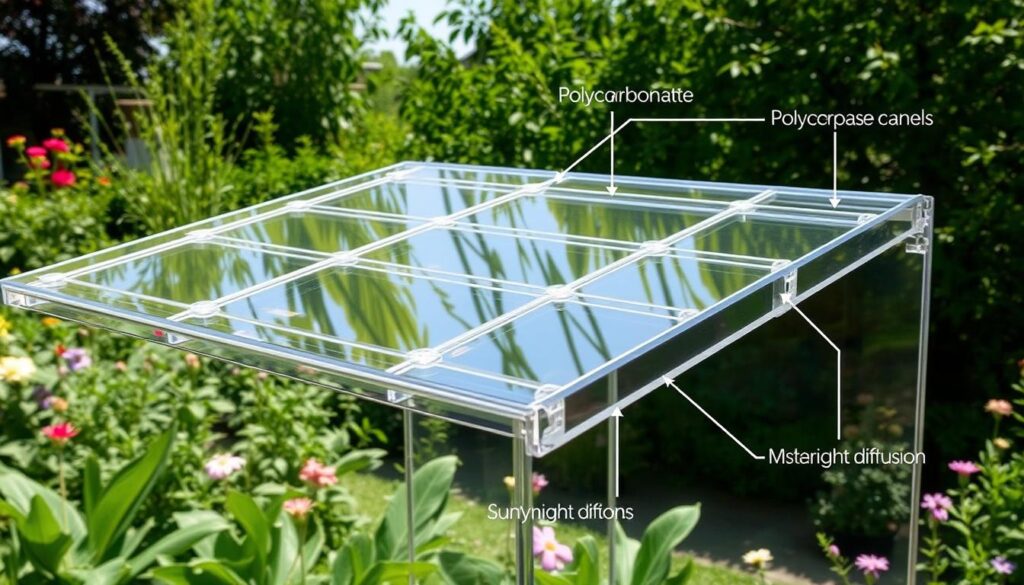
How to Replace a Broken Greenhouse Pane
A broken greenhouse pane can be replaced effectively with the right tools and instructions. Replacing a broken pane is crucial to maintaining your greenhouse’s climate and structural integrity.
Tools and Materials You’ll Need
To replace a broken greenhouse pane, you’ll need a few essential tools and materials. These include a greenhouse glass replacement kit, which typically contains glazing clips, a glazing bead, or other necessary fixings. You may also require a putty knife, gloves, safety glasses, and a measuring tape.
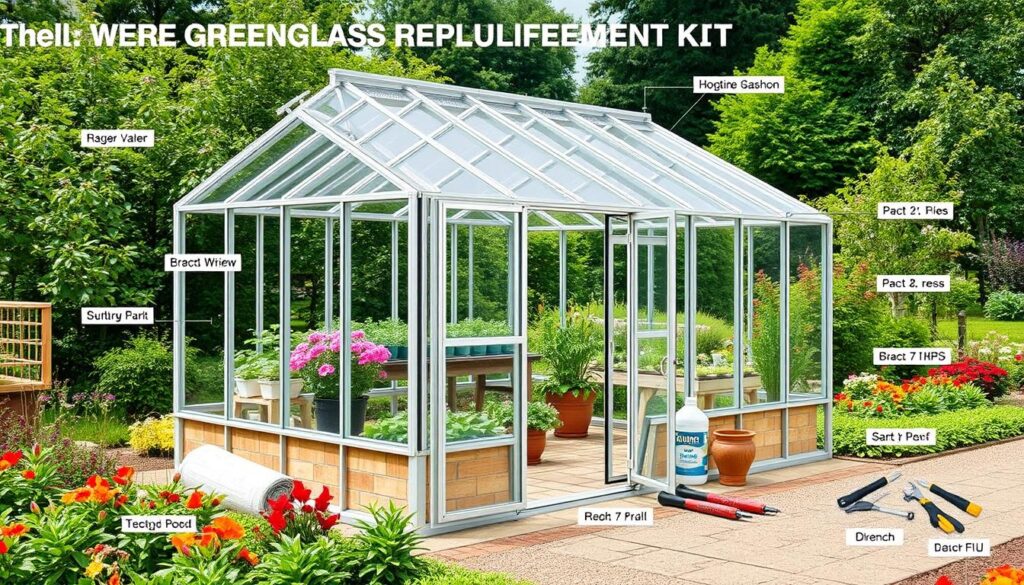
Removing the Broken Pane Safely
When removing the broken pane, safety is paramount. Wear protective gloves and safety glasses to prevent injury from sharp glass fragments. Carefully remove any remaining glass pieces from the frame, taking note of the glazing method used (e.g., glazing beads or clips).
Clear the area around the broken pane, and gently prise out the glazing beads or release the clips holding the glass in place. This will allow you to safely remove the remaining shards or the entire broken pane.
Measuring for Your Replacement Pane
To ensure a proper fit, measure the dimensions of the opening in your greenhouse frame. Take multiple measurements across both width and height to account for any irregularities. When ordering replacement glass or alternative materials like acrylic or polycarbonate sheets, consider allowing for expansion gaps.
For plastic replacement materials, calculate an expansion allowance of approximately 0.6 mm per metre for every 10 degrees of expected temperature variation. Measure the thickness of the original greenhouse glass to ensure your replacement material will fit properly in the existing glazing channels or clips.
Choosing the Right Material for Your Greenhouse
When it comes to selecting the ideal material for your greenhouse, several factors need to be considered to ensure optimal performance and longevity. The choice of material affects not only the initial cost but also the long-term maintenance, energy efficiency, and overall health of your plants.
Glass vs. Polycarbonate: A Detailed Comparison
Glass and polycarbonate are two popular materials used in greenhouse construction, each with its own set of advantages. Glass offers excellent light transmission and aesthetic appeal, making it a popular choice for many gardeners. However, it can be heavy and prone to breakage. On the other hand, polycarbonate is lighter and more impact-resistant than glass, making it a practical choice for areas prone to hail or extreme weather conditions. While it may not offer the same level of clarity as glass, high-quality polycarbonate can provide excellent light diffusion.
Light Transmission Considerations
Light transmission is a critical factor in greenhouse material selection, as it directly affects plant growth. Glass typically offers high light transmission, often above 90%. Polycarbonate and acrylic materials can also provide good light transmission, although it may be slightly lower than glass. The choice of material should be based on the specific needs of your plants and the local climate conditions.
Weather Resistance and Durability Factors
Weather resistance is crucial for greenhouse materials, as they are exposed to various environmental factors. Glass is highly resistant to weather conditions and UV exposure, maintaining its clarity over decades. Polycarbonate sheets are also engineered to be weather-resistant, capable of withstanding extreme conditions including heavy snow loads and hail impacts. Acrylic panels are known for their UV resistance, preventing yellowing over time. When selecting a material, consider your local climate and the expected lifespan of the material. For instance, areas with heavy snowfall may benefit from stronger polycarbonate roof panels, while glass might be suitable for side panels.
The expected lifespan varies significantly between materials. Glass can last indefinitely if not broken, while quality polycarbonate typically offers 10-15 years of optimal performance. Regular maintenance, including cleaning and occasional resealing of frames and joints, is essential for all greenhouse materials to maintain their weather resistance.
Installing Your New Greenhouse Pane
Now that you have your replacement pane, let’s walk through the steps to install it correctly. Installing a new pane in your greenhouse is a straightforward process if you have the right tools and follow the correct procedure.
Step-by-Step Installation Guide
To begin, ensure you have all the necessary tools and materials within reach. Start by cleaning the frame where the new pane will be installed, removing any debris or old glazing material. If you’re using a plastic sheet like acrylic or polycarbonate, make sure it’s cut to the correct size, leaving a small margin for expansion.
Carefully place the new pane into the frame, ensuring it’s properly seated and aligned. Use a soft cloth or gloves to handle the pane to prevent fingerprints and scratches.
Securing the Pane Properly
Once the pane is in place, secure it using the appropriate fixings. For plastic glazing materials, use flexible glazing strips or rubber seals to accommodate the natural movement of the material. Avoid overtightening, which can cause buckling or cracking. Install fixings in a way that allows for slight movement of the pane within the frame.
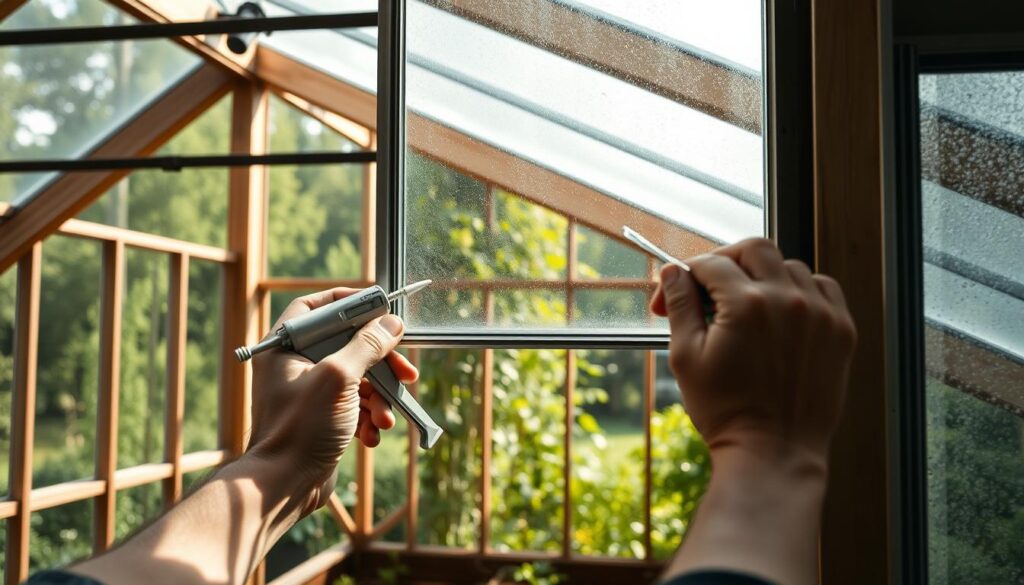
Dealing with Expansion and Contraction
Understanding thermal expansion is crucial when installing plastic greenhouse glazing materials. Acrylic and polycarbonate expand and contract more significantly than glass. To accommodate this, leave an expansion gap of approximately 0.6 mm per metre for every 10 degrees of expected temperature variation. When cutting your plastic sheet to size, make the panel slightly smaller than the actual frame opening to allow for this expansion.
By following these steps and considering the unique properties of your chosen glazing material, you can ensure a successful installation that will keep your greenhouse functioning optimally for years to come.
Maintaining Your Greenhouse Glazing for Longevity
Proper maintenance of your greenhouse glazing can significantly extend its lifespan and efficiency. This involves regular cleaning, inspections, and taking steps to prevent future breakages. By doing so, you can ensure your greenhouse continues to provide an optimal environment for your plants.
Regular Cleaning and Inspection Tips
Regular cleaning is essential to maintain the light transmission through your greenhouse glazing. Use a high-quality cleaning product like Vuplex to remove dirt and grime without leaving streaks or residue. Inspect your glazing regularly for signs of damage or wear, such as cracks in the glass or degradation of acrylic polycarbonate panels.
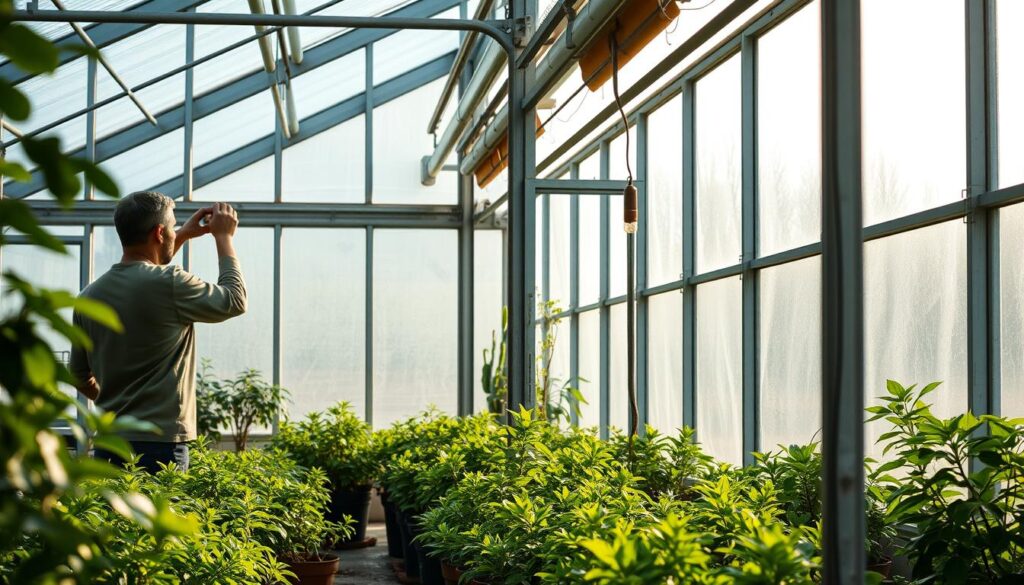
Preventing Future Breakages
To prevent future breakages, consider installing protective measures such as windbreaks or barriers around your greenhouse. Regularly trim overhanging branches and maintain the structural integrity of your greenhouse frame. If your greenhouse is in an area prone to impact, consider replacing vulnerable panels with stronger glass or acrylic polycarbonate alternatives. Applying a safety film to traditional glass panels can also reduce the risk of shattering.
- Install windbreaks or barriers to reduce impact damage.
- Trim overhanging branches to prevent falling debris.
- Maintain the greenhouse frame’s structural integrity.
- Consider stronger alternatives for vulnerable panels.
Conclusion
With the right materials and techniques, you can easily replace a broken greenhouse pane and improve your growing conditions. The choice between traditional glass, acrylic, and polycarbonate materials depends on your specific needs regarding durability, light transmission, insulation, and budget.
Modern materials like acrylic polycarbonate offer compelling advantages in terms of impact resistance and weight. Proper measurement and installation techniques are crucial for a successful replacement. Regular maintenance will extend the lifespan of your greenhouse glazing and ensure optimal conditions for your plants.
By considering the full range of products and services available, including cut-to-size options, you can simplify the replacement process. With the right approach, your repaired greenhouse can provide many years of reliable service for your gardening endeavours.
